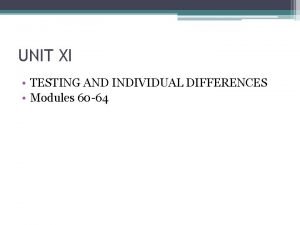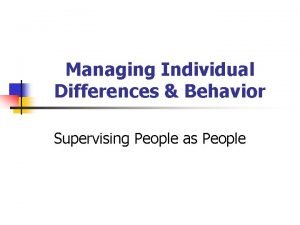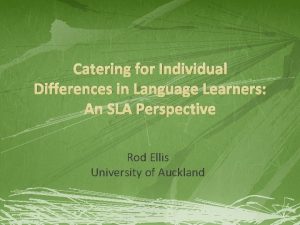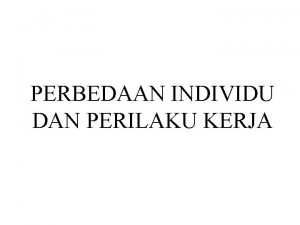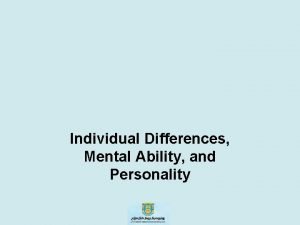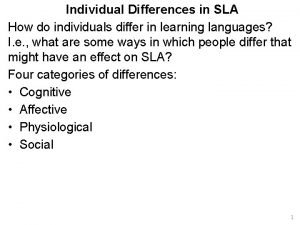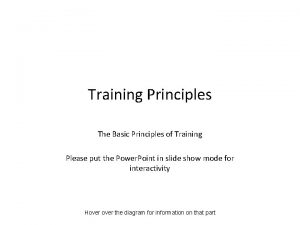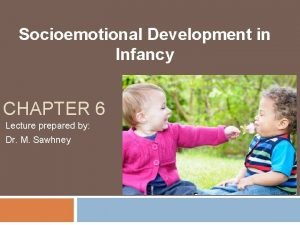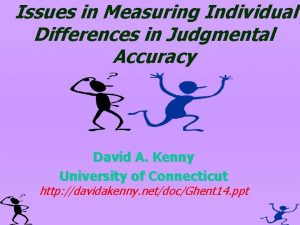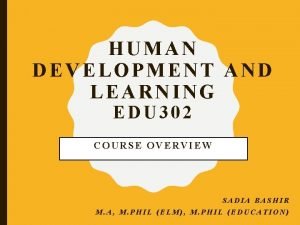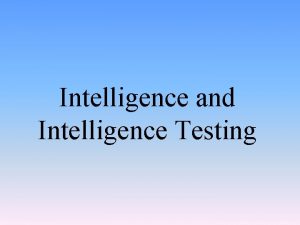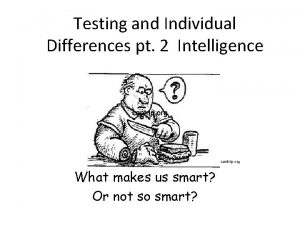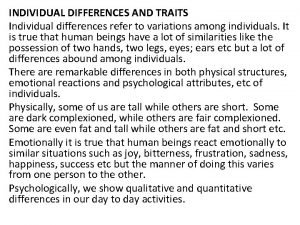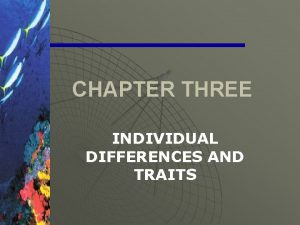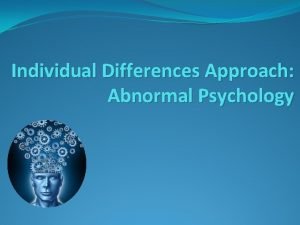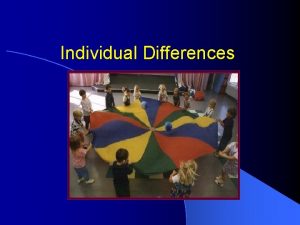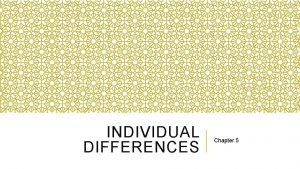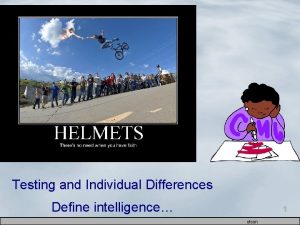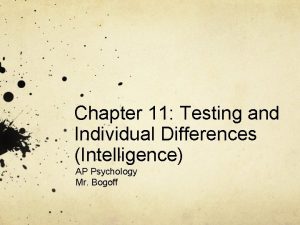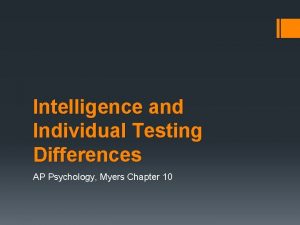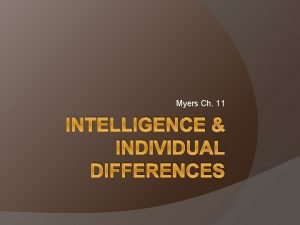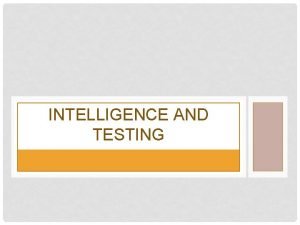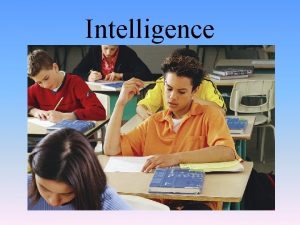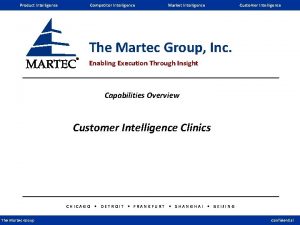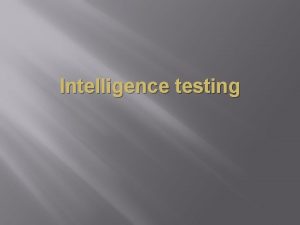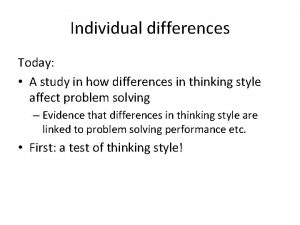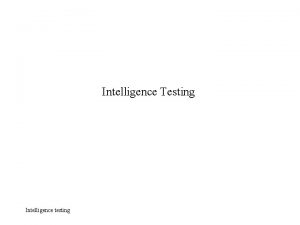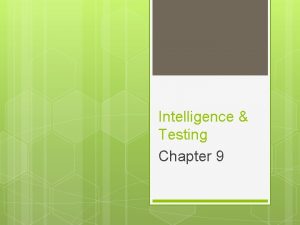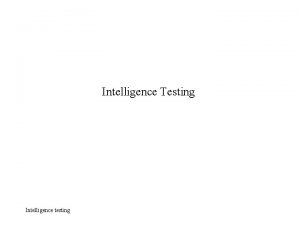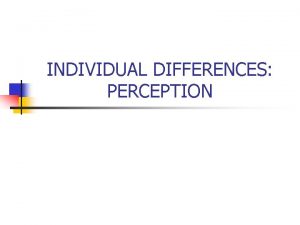Testing and Individual Differences pt 2 Intelligence cantrip



























- Slides: 27

Testing and Individual Differences pt. 2 Intelligence cantrip. org What makes us smart? Or not so smart?

Intelligence and Intelligence Testing • Intelligence: aggregate or global capacity of the individual to act purposefully, to think rationally, and to deal effectively with his environment. failfun. com

Standardization and Norms • Standardization: is a two part test development procedure that first establishes test norms from the test results of the large sample. • Norms are scores established from the test. For example the means core for the SAT is 500. – When administering a standardized test, all proctors must give same directions and conditions and scores sheets.

How do we construct an Intelligence Test? • Standardized: the questions have been piloted on similar populations and the scores fall on a normal distribution. • Reliable: Test-Retest, Split-halves Methods. • Validity: Content, Predictive or Construct.

Reliability and validity • Reliability refers to when you can obtain the same score no matter where, when or how many times we take it. • ***The closer the correlation coefficient is to 1. 0 the more reliable the test. Test-Retest Reliablity: Give test to a large group, then give exactly the same test to same group later and you should get the same results. Split-Half: The test is split into two equal parts (odd-even) and scores are compared.

Reliability and validity • Valid: it is accurate. The test accurately measures or predicts what it is suppose to. – Face Validity: Looks like it tests what it’s supposed to or claims to test – Content Validity: measure extent of the knowledge – Criterion related validity: The test is measured against an overall goal or proficiency (meeting the criteria). (High School Graduation Exam) – Predictive Validity: forecasts a specific future result. For example. The SAT is designed to predict how well someone will succeed in their freshman year in college. – Construct Validity: measures behavior. For example the MMPI.

Types of Tests • Performance Tests: SAT’s , AP, Wechsler intelligence test, Stanford-Binet intelligence, classroom tests, finals, driver’s license • Observational Tests: person being tested does not have a single well defined task but assessed on typical behavior. : Employment interviews, on the job observations. • Self-Report Tests require the test taker to describe his or her feelings, attitudes, beliefs, values, opinions, physical state: MMPI

Another Type of Tests can be categorized into ability, interest, and personality tests relevant to decision making: • Aptitude: • Measure ability or potential. Achievement: Tests that measure what you have learned.

The Normal Distribution of IQ Scores Normal Range Number of Persons Many Few 0 10 20 30 40 50 60 70 80 90 100 110 120 130 140 150 160 170 180 190 200 IQ Normal Range : Scores falling near the middle of a normal distribution Copyright © Allyn & Bacon 2007

Types of Tests 1. Objective Tests Can be scored easily by a machine 2. Subjective Tests Individuals are asked to write answers rather true/false, multiple than choose from a set of possible answers choice, anything you § can scantron Subjective tests are more challenging and expensive to prepare, administer and evaluate correctly, but they can be more valid. Copyright © Allyn & Bacon 2007

Ethics and Standards in Testing Ethical concerns related to testing involve: --The confidentiality of the test results --How to report the results --How to use the test to compare individuals --The impact of tests on society as a whole Copyright © Allyn & Bacon 2007

Ethics and Standards in Testing • Because some groups (such as African Americans) have tended to score lower on average than other groups (such as European Americans) on intelligence tests and SATS, critics argue that tests are bias. Not biases with respect to predictive validity but biased with respect to performance differences from cultural experience. • Culture relevant tests incorporate skills and knowledge related to the cultural experiences of the test takers. Ex. Questions about boll weevil

Intelligence and Intelligence Testing • Alfred Binet and Simon were hired by the French government to identify children who would not benefit from a traditional school setting and those who would benefit from special education. It was only meant to be used for class placement.

Terman and his IQ Test 'Stanford-Binet Intelligence Scale' • Used Binet’s research to construct the modern day IQ test called the Stanford. Binet Test. • IQ=Mental age/Chronological age X 100. • A 8 year old has a mental age of 10, what is her IQ? • A 12 year old has the mental age of 9, what is his IQ? • A boy has the mental age of 10 and an IQ of 200, how old is he?

Wechsler Tests • David Wechsler developed another set of age-based intelligence tests. More common way to give IQ tests…. does not use the formula but uses the same scoring system. • More helpful for determining the extremes of intelligence.

Mental Retardation vs. Genius • Mental Retardation: When test takes fall below the mean score of 70 on IQ test. Weshsler test. WAIS

Genius: when above 130

Goleman and his EQ Emotional Intelligence • Interpersonal and intrapersonal intelligences. • Maybe EQ is a better predictor future success than IQ.

Creativity • Creativity: ability to generate ideas and solutions that are original, novel, and useful. Not usually measured by intelligence tests. • Threshold Theory: a certain level of intelligence is necessary but not sufficient for creative work.

Heredity/Environment and Intelligence • Nature/Nurture controversy: • Nature: what extent is intelligence – Down’s Syndrome hereditary and what is Nurture: learned. Fetal Alcohol Syndrome (environmental)

Heredity/Environment and Intelligence • Studies of Twins: • Identical twins have similar scores on intelligence tests. Intelligence scores of adoptees are more like those of their biological parents than their adopted parents. Brain scans of twins reveal similar brain volume and anatomy.

Heredity/Environment and Intelligence • Environmental Influences on Intelligence: : • Siblings raised together are more similar in IQ than siblings raised apart. • Children from deprived homes then moved into middle/upper class foster homes tend to increase IQ. School attendance results in increased IQ scores. In fact, scores tend to steadily increase. James Flynn observed that when we start doing better on tests. Called the FLYNN EFFECT

Minnesota Transracial Adoption Study 1976, 1992 Also called the Scarr and Weinberg Adoption Study Revealed the strength of environment in determining IQ levels. Examined the IQ test scores of 130 black/interracial children adopted by advantaged white families. Copyright © Allyn & Bacon 2007

Heritability and Group Differences § Research with twins and adopted children shows genetic influences on a wide range of attributes, including intelligence § Research has also shown that racial and class differences in IQ scores can be eliminated by environmental changes Copyright © Allyn & Bacon 2007

Effects on I. Q. § Social Class § Affects IQ in terms of nutrition, health care, education. § Head Start Program § Provides an enriched environment for disadvantaged children. § Test Biases § Can increase or decrease test scores.

Test Bias on IQ tests can also influence the scores. By doing some intelligence tests which make non-mainstream cultural assumptions, students can come to experience some of the difficulties and issues involved with culturally biased methods of testing intelligence. Copyright © Allyn & Bacon 2007

Brain Size and Intelligence Is there a link? • Small +. 15 correlation between head size and intelligence scores (relative to body size). • Using an MRI we found +. 44 correlation with brain size and IQ score.
 Unit xi testing and individual differences
Unit xi testing and individual differences Managing individual differences and behavior
Managing individual differences and behavior Proactive personality
Proactive personality Individual differences factors
Individual differences factors Catering to individual differences
Catering to individual differences Hukum perbedaan individu
Hukum perbedaan individu Apa makna perbedaan individu dalam dunia kerja
Apa makna perbedaan individu dalam dunia kerja What are type a people
What are type a people Individual differences in sla
Individual differences in sla Principles of training variation
Principles of training variation Principles of training individual differences
Principles of training individual differences Thomas and chess temperament
Thomas and chess temperament Conclusion of individual differences
Conclusion of individual differences Difference between growth and development
Difference between growth and development Positive and negative testing
Positive and negative testing Cs 3250
Cs 3250 A survey of the history of intelligence testing reinforces
A survey of the history of intelligence testing reinforces Audience intelligence testing
Audience intelligence testing Intelligence testing
Intelligence testing Intelligence quotient
Intelligence quotient Domain testing
Domain testing Motivational overview in software testing
Motivational overview in software testing Data flow testing strategies in software testing
Data flow testing strategies in software testing What is globalization testing
What is globalization testing Functional testing vs unit testing
Functional testing vs unit testing Language testing
Language testing Control structure testing in software engineering
Control structure testing in software engineering Decision table testing in software testing
Decision table testing in software testing
